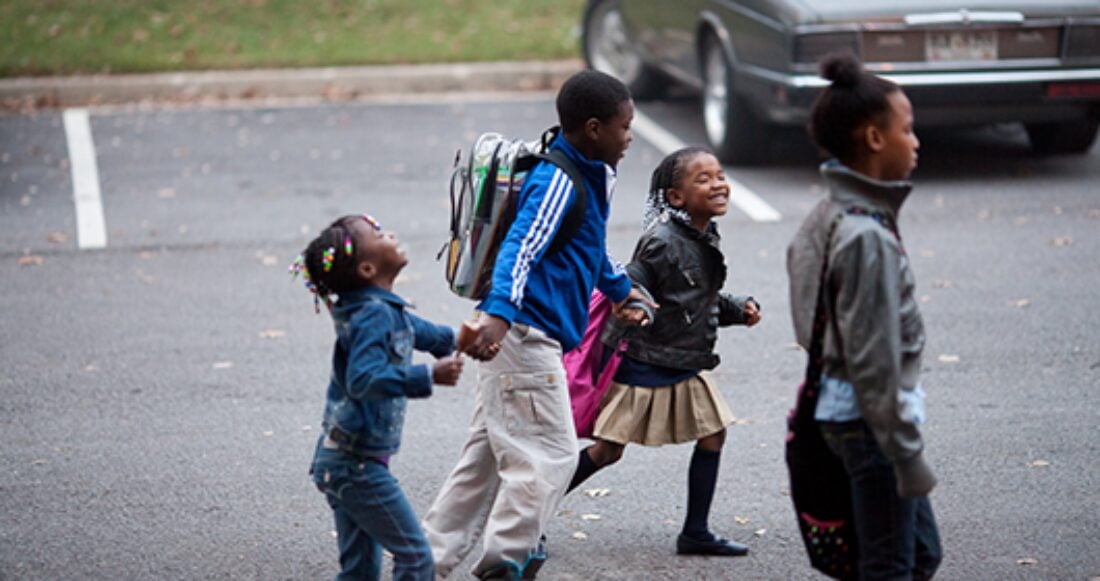Poverty and Barriers to Opportunity in Atlanta

As Atlanta’s economy thrives, many residents of color are left behind
ATLANTA — Although the city is considered an economic powerhouse and “black mecca,” its wealth and promise don’t extend to many of its residents, particularly those of color, who struggle to make ends meet, get family-supporting jobs and access quality education and other key resources. A new report from the Annie E. Casey Foundation, Changing the Odds: The Race for Results in Atlanta, highlights the city’s north-south divide and data showing that where children and families live — often synonymous with their racial or ethnic background — can determine their prospects for success in life.
Atlanta’s racial demographics of poverty
In Atlanta, the east-west I‑20 separates wealthier, majority-white communities in the north from poorer, majority-black communities in the south. African American residents represent at least 80% of the population in 12 of the 17 NPUs located along or below I‑20.
Examining the racial disparities of poverty in Atlanta
The report explores how race and community of residence create persistent barriers, resulting in sharp differences in the educational and economic opportunities available to Atlantans of color, and to children and families on the city’s north and south sides. The reality for black residents is particularly troubling. Among the report’s findings:
- Eighty percent of Atlanta’s African-American children live in communities with high concentrations of poverty, compared with 6 percent of their white peers and 29 percent of Asians. Forty-three percent of Latino kids live in these neighborhoods, which frequently lack access to critical resources such as high-performing schools and quality medical care. Only five of the city’s neighborhood planning units (NPUs) along or south of Interstate 20 have poverty rates below 20 percent, and four have poverty rates higher than 40 percent.
- The unemployment rate for African Americans in Atlanta (22 percent) is nearly twice the city’s overall 13 percent, more than three times higher than the rate for their white counterparts (6 percent) and more than twice the rate for Latinos (9 percent). White residents earn more than three times as much as their black counterparts, twice as much as Latinos and about $30,000 more than Asians in the city.
- Graduation rates for black and Latino students in Atlanta Public Schools are 57 percent and 53 percent, compared with 84 percent and 94 percent, respectively, for white and Asian students. Black and Latino students are more than three times more likely to drop out of school.
“Atlanta appears to be thriving, but it’s clear that many of its residents of color, especially children and youth, are being left behind — to everyone’s detriment,” said Kweku Forstall, who leads the Foundation’s work in Atlanta, which primarily focuses on improving the lives of children and families in the communities of NPU‑V. “We must work together — in the public, private and philanthropic sector — to help ensure all children and families have the chance to realize their potential and fully contribute to their city and the local economy.”
Changing the Odds details the various elements — some rooted in public policies and practices established decades ago — that have led to the significant differences in outcomes and opportunity among city residents. These include a history of segregation in public housing, zoning and schools, as well as recent redevelopment that has reduced affordable housing options for lower-income families. In addition, lackluster graduation rates among students of color stem from such factors as the wide variance in out-of-school suspensions, particularly between white and black students, as well as the poor quality of learning environments in schools with predominantly black student enrollment. The report also notes the concentration of jobs and job growth in the northern metro area, which frequently puts employment opportunities out of reach for mostly black residents living on Atlanta’s south side, many of whom don’t own a vehicle.
The report offers three recommendations to address the barriers to opportunity that many children and families of color, especially on the south side, encounter:
- Increase investments in low-income communities to support their economic growth by developing and preserving affordable housing; promoting equitable development practices that benefit diverse racial, ethnic and socioeconomic groups; and bolstering small businesses and enterprises in low-income neighborhoods and communities of color.
- Support strategies that prepare young children and youth for success in school and beyond by increasing access to high-quality early child care and education, especially in low-income neighborhoods; harnessing the state’s quality-rating system to foster learning environments that encourage student attendance and achievement; and distributing public, private and philanthropic resources equitably among schools.
- Pursue strategies to improve employment opportunities for local residents by aligning job-training programs with employers’ needs in high-growth sectors such as information technology and health care; adopting ban-the-box policies in the private sector so that criminal records aren’t an automatic barrier to employment; and expanding public transit systems in the northern metro area, where well-paying jobs are concentrated.





